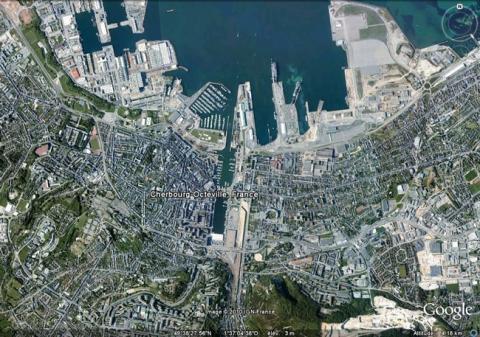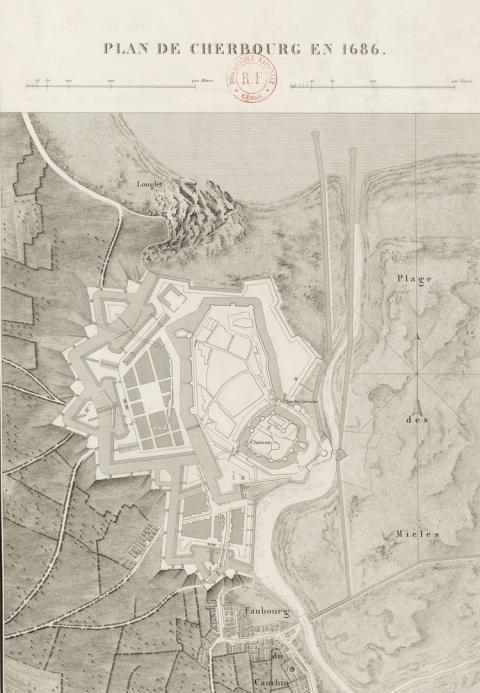Cherbourg
History and description
A town of Roman origin and a defensive siege construction made by Litus, Cherbourg has had a castle since the 10th century. The first urban wall is thought to have been constructed shortly after. After multiple battles and sieges between France and England, the town was permanently returned to France in 1450. The castle and the medieval ramparts were then restored at the time. In the course of the 16th-17th centuries, the fortifications were upgraded with some modern works but what Vauban discovered during an inspection in 1686 was a urban wall and a castle in ruins, and moats silted up. He emphasised the strategic importance of the port which faced England. In 1639, the commissioner general of the navy of Louis XIII, Louis le Roux d’Infréville submitted a report underlining the importance of Cherbourg but was largely ignored.Vauban proposed an identical project in 1686, the main elements of which were as follows: firstly, dig up the moats, subsequently, construct five new bastions and a hornwork to protect the town and extend it to the west and south. This was further modified in 1694 and 1699 by the installation of cannon towers on the Pelée Island and on the Homet rock. However, he had no interest whatsoever in setting up Cherbourg as a military port, since he was too focused on the construction he was overseeing in Brest and Saint-Malo at the same time. As for the construction commenced in 1687, they were abandoned by Louvois in 1689. The medieval castle was demolished in 1688.
Other projects were pursued under the Regency and under the effective reign of Louis XV, only one of which came to fruition: the construction of the first fort de Querquinville in 1756. This fort was insufficient to protect Cherbourg from an English attack two years later. It was not until 1774, on the eve of the French involvement in the American war of Independence, that Louis XVI agreed to reconsider Cherbourg as a site for a military port. In 1779, the engineer de Caux took up the projects of Vauban and fortified the Pelée island and the Homet rock with the construction of the fort Royal (1782-1785) on the first island, that of the vaulted fort d’Artois (1779-1785) on the second. In 1787, the fort de Querquinville was reconstructed, vaulted and equipped with a hornwork and moats. The construction of the port arsenal commenced in 1788, under the orders of Duke Harcourt, governor of Normandy, who had convinced Louis XVI of the need to create a large dam to protect the anchorage. The French Revolution interrupted the construction in 1792. Work recommenced under the Consulate. In 1806, the first basin was inaugurated by the Empress Marie-Louise, but it was not until 1853 that the port arsenal was completed. Napoléon III added three external forts there, as a means of protecting the dam in 1860. During the German Occupation, the Todt Organisation undertook huge construction work in Cherbourg, included in the Wall of the Atlantic in 1942, as Festung, namely, a fortified military port also equipped with numerous bunkers. After the Liberation, the port was reconstructed and modernised.
Current state
The forts of Pelée Island and the Homet rock, and the dams and basins of the port arsenal still exist, although they were modified and damaged during the Second World War. They can be visited by arrangement with the local tourist office. However, nothing further is left of the urban wall and the buildings of the arsenal from the 18th and 19th centuries, although the site is still occupied by the French navy. To see details of the former, it is necessary to review the relief map of the 19th century preserved at the musée des Invalides in Paris.
Cherbourg
Cherbourg
49° 38' 20" N, -1° 37' 30" E
Type
urban wall
Engineers
Louis Le Roux d’Infréville, Sébastien le Prestre de Vauban, Benjamin de Combes, Pierre-Jean de Caux
Department
Manche
Region
Normandie
Bibliography
- FAUCHERRE (N.), LECUYER (G.), La route des fortifications en Bretagne Normandie, Paris, 2006.
- FOURNIER (P.), « La place forte de Cherbourg au XIXe siècle » in Vauban et ses successeurs sur les côtes de la Manche, Paris, 2003, p.345-353.
- FOURNIER (P.), « Les forts de Cherbourg » in Vauban et ses successeurs sur les côtes de la Manche, Paris, 2003, p.355-362.
- PROST (P.), « Le contexte général et stratégique de Cherbourg » in Vauban et ses successeurs sur les côtes de la Manche, Paris, 2003, p.95-105.
- WARMOES (I.), Le Musée des Plans-Reliefs, Paris, 1997, p.63-64.

